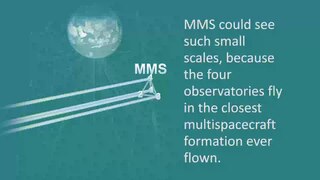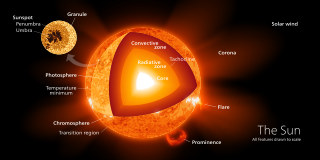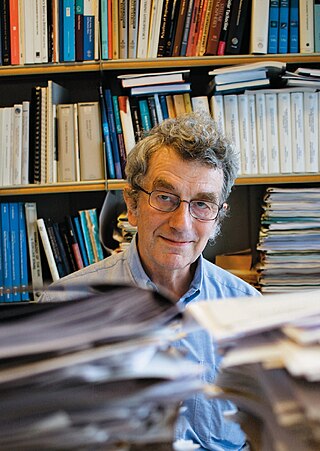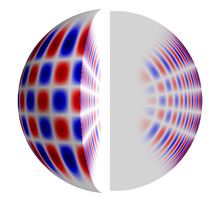
CoRoT was a space telescope mission which operated from 2006 to 2013. The mission's two objectives were to search for extrasolar planets with short orbital periods, particularly those of large terrestrial size, and to perform asteroseismology by measuring solar-like oscillations in stars. The mission was led by the French Space Agency (CNES) in conjunction with the European Space Agency (ESA) and other international partners.

Asteroseismology is the study of oscillations in stars. Stars have many resonant modes and frequencies, and the path of sound waves passing through a star depends on the speed of sound, which in turn depends on local temperature and chemical composition. Because the resulting oscillation modes are sensitive to different parts of the star, they inform astronomers about the internal structure of the star, which is otherwise not directly possible from overall properties like brightness and surface temperature.
Solar radius is a unit of distance used to express the size of stars in astronomy relative to the Sun. The solar radius is usually defined as the radius to the layer in the Sun's photosphere where the optical depth equals 2/3:

In plasma physics, an Alfvén wave, named after Hannes Alfvén, is a type of plasma wave in which ions oscillate in response to a restoring force provided by an effective tension on the magnetic field lines.

Stellar structure models describe the internal structure of a star in detail and make predictions about the luminosity, the color and the future evolution of the star. Different classes and ages of stars have different internal structures, reflecting their elemental makeup and energy transport mechanisms.

Neutrino oscillation is a quantum mechanical phenomenon in which a neutrino created with a specific lepton family number can later be measured to have a different lepton family number. The probability of measuring a particular flavor for a neutrino varies between three known states, as it propagates through space.

Solar rotation varies with latitude. The Sun is not a solid body, but is composed of a gaseous plasma. Different latitudes rotate at different periods. The source of this differential rotation is an area of current research in solar astronomy. The rate of surface rotation is observed to be the fastest at the equator and to decrease as latitude increases. The solar rotation period is 24.47 days at the equator and almost 38 days at the poles. The average rotation is 28 days.

The tachocline is the transition region of stars of more than 0.3 solar masses, between the radiative interior and the differentially rotating outer convective zone. This causes the region to have a very large shear as the rotation rate changes very rapidly. The convective exterior rotates as a normal fluid with differential rotation with the poles rotating slowly and the equator rotating quickly. The radiative interior exhibits solid-body rotation, possibly due to a fossil field. The rotation rate through the interior is roughly equal to the rotation rate at mid-latitudes, i.e. in-between the rate at the slow poles and the fast equator. Recent results from helioseismology indicate that the tachocline is located at a radius of at most 0.70 times the solar radius, with a thickness of 0.04 times the solar radius. This would mean the area has a very large shear profile that is one way that large scale magnetic fields can be formed.
The standard solar model (SSM) is a mathematical treatment of the Sun as a spherical ball of gas. This model, technically the spherically symmetric quasi-static model of a star, has stellar structure described by several differential equations derived from basic physical principles. The model is constrained by boundary conditions, namely the luminosity, radius, age and composition of the Sun, which are well determined. The age of the Sun cannot be measured directly; one way to estimate it is from the age of the oldest meteorites, and models of the evolution of the Solar System. The composition in the photosphere of the modern-day Sun, by mass, is 74.9% hydrogen and 23.8% helium. All heavier elements, called metals in astronomy, account for less than 2 percent of the mass. The SSM is used to test the validity of stellar evolution theory. In fact, the only way to determine the two free parameters of the stellar evolution model, the helium abundance and the mixing length parameter, are to adjust the SSM to "fit" the observed Sun.
Frequency separation within astrophysics, is a term used in both Helioseismology and Asteroseismology. It refers to the spacing in frequency between adjacent modes of oscillation, having the same angular degree (l) but different radial order (n).
Solar-like oscillations are oscillations in stars that are excited in the same way as those in the Sun, namely by turbulent convection in its outer layers. Stars that show solar-like oscillations are called solar-like oscillators. The oscillations are standing pressure and mixed pressure-gravity modes that are excited over a range in frequency, with the amplitudes roughly following a bell-shaped distribution. Unlike opacity-driven oscillators, all the modes in the frequency range are excited, making the oscillations relatively easy to identify. The surface convection also damps the modes, and each is well-approximated in frequency space by a Lorentzian curve, the width of which corresponds to the lifetime of the mode: the faster it decays, the broader is the Lorentzian. All stars with surface convection zones are expected to show solar-like oscillations, including cool main-sequence stars, subgiants and red giants. Because of the small amplitudes of the oscillations, their study has advanced tremendously thanks to space-based missions.

Ross 548 is a white dwarf in the equatorial constellation of Cetus. With a mean apparent visual magnitude of 14.2 it is much too faint to be visible to the naked eye. Based on parallax measurements, it is located at a distance of 107 light years from the Sun. It was found to be variable in 1970 and in 1972 it was given the variable star designation ZZ Ceti. This is a pulsating white dwarf of the DAV type that is the prototype of the ZZ Ceti variable class., pp. 891, 895.

Asteroseismology studies the internal structure of the Sun and other stars using oscillations. These can be studied by interpreting the temporal frequency spectrum acquired through observations. In the same way, the more extreme neutron stars might be studied and hopefully give us a better understanding of neutron-star interiors, and help in determining the equation of state for matter at nuclear densities. Scientists also hope to prove, or discard, the existence of so-called quark stars, or strange stars, through these studies. Fundamental information can be obtained of the General Relativity Theory by observing the gravitational radiation from oscillating neutron stars.
Coronal seismology is a technique of studying the plasma of the Sun's corona with the use of magnetohydrodynamic (MHD) waves and oscillations. Magnetohydrodynamics studies the dynamics of electrically conducting fluids - in this case the fluid is the coronal plasma. Observed properties of the waves (e.g. period, wavelength, amplitude, temporal and spatial signatures, characteristic scenarios of the wave evolution, combined with a theoretical modelling of the wave phenomena, may reflect physical parameters of the corona which are not accessible in situ, such as the coronal magnetic field strength and Alfvén velocity and coronal dissipative coefficients. Originally, the method of MHD coronal seismology was suggested by Y. Uchida in 1970 for propagating waves, and B. Roberts et al. in 1984 for standing waves, but was not practically applied until the late 90s due to a lack of necessary observational resolution. Philosophically, coronal seismology is similar to the Earth's seismology, helioseismology, and MHD spectroscopy of laboratory plasma devices. In all these approaches, waves of various kind are used to probe a medium.
The Phoebus group is an international team of European, Japanese and American scientists aiming at detecting the solar g modes. As of October 5, 2009, the group has finally produced a review summarising the work performed over the past 12 years.

Philip R. Goode is an American theoretical physicist also working in observational astronomy and its instrumentation. He is a Distinguished Research Professor of Physics at New Jersey Institute of Technology (NJIT) with an H-index > 60. His career divides into five overlapping periods as follows:

Jørgen Christensen-Dalsgaard is a Danish astronomer at Aarhus University in Denmark. He specializes in asteroseismology and helioseismology. He has made significant contributions to both fields, including predicting the oscillation of Sun-like stars in 1983. He is the head of "Rumudvalget" and the Stellar Astrophysics Centre (SAC) supported by the Danish National Research Foundation. He is co-investigator on the Kepler mission and, with Hans Kjeldsen in Aarhus, leads the 500+ researchers in the Kepler Asteroseismic Science Consortium (KASC). KASC is responsible for the asteroseismology component of the Kepler mission. Christensen-Dalsgaard has published several papers on this subject. He was also previously the president of Commission 27 of the International Astronomical Union.
Douglas Owen Gough FRS is a British astronomer, Professor Emeritus of Theoretical Astrophysics in the University of Cambridge, and Leverhulme Emeritus Fellow.
Yvonne Elsworth FRS FInstP FRAS is an Irish physicist, Professor of Helioseismology and Poynting Professor of Physics in the School of Physics and Astronomy at the University of Birmingham. Elsworth was until 2015 also the Head of the Birmingham Solar Oscillations Network (BiSON), the longest running helioseismology network with data covering well over three solar cycles.
Solar radio emission refers to radio waves that are naturally produced by the Sun, primarily from the lower and upper layers of the atmosphere called the chromosphere and corona, respectively. The Sun produces radio emissions through four known mechanisms, each of which operates primarily by converting the energy of moving electrons into electromagnetic radiation. The four emission mechanisms are thermal bremsstrahlung (braking) emission, gyromagnetic emission, plasma emission, and electron-cyclotron maser emission. The first two are incoherent mechanisms, which means that they are the summation of radiation generated independently by many individual particles. These mechanisms are primarily responsible for the persistent "background" emissions that slowly vary as structures in the atmosphere evolve. The latter two processes are coherent mechanisms, which refers to special cases where radiation is efficiently produced at a particular set of frequencies. Coherent mechanisms can produce much larger brightness temperatures (intensities) and are primarily responsible for the intense spikes of radiation called solar radio bursts, which are byproducts of the same processes that lead to other forms of solar activity like solar flares and coronal mass ejections.










































